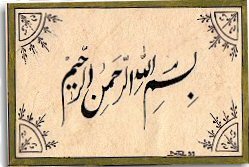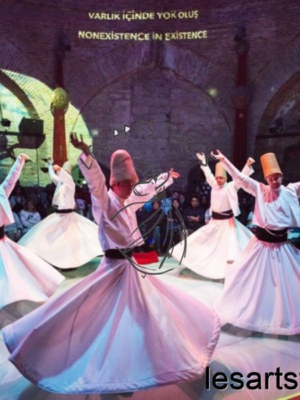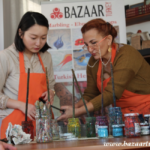When we speak of Turkish calligraphy, we refer to writing of aesthetic value in characters based on the Arabic script, which the Turks had adopted as their writing medium after their conversion to Islam. The Arabic characters gradually assumed an aesthetic function after the advent of Islam, and this process gathered momentum from the mid-eighth century onwards, so that calligraphy was already a significant art discipline by the time the Turks joined the Islamic world. Therefore it is necessary to begin with a brief review of the structure of Arabic characters and their development during the early centuries of Islam. The most succinct definition of calligraphy formulated by Islamic writers is, “Calligraphy is a spiritual geometry produced with material tools.” The aesthetic values implied by this definition held true for centuries.

Under this writing system most of the letters underwent a change of form according to whether they were positioned at the beginning, middle or end of a word. When transformed into an art the characters took on highly elaborate shapes, and the rich visual impact attained when they were joined together, and above all the fact that the same word or phrase could be written in various ways opened the door to the infinite variety and innovation which is a prerequisite of art. Just as the characters could be written singly in several different ways, so there was an astonishing diversity of different scripts or “hands”. The Arabic characters were adopted — primarily motivated by religious fervour by virtually all the peoples who converted to Islam, so that just a few centuries after the Hegira they had become the shared property of the entire Muslim world. The term “Arabic calligraphy”, which is appropriate with respect to the early period, broadened in scope over time to become what more accurately might be described as “Islamic calligraphy”.

This writing system, known as nabatî because it was used by the Nabat tribe in pre-Islamic times, derives from the Phoenician. In its early form, the script gave no clue of its future potential as such a powerfully aesthetic medium, the characters consisting of very simple shapes.
With the emergence of Islam, however, and particularly after the Hegira, the Arabic script became the literary vehicle of the last Semitic religion. The numbers of those literate in the Arabic script multiplied rapidly, and in time it was perfected into a vehicle equipped to record the Koran, and hence the language as a whole, with precision. Vowel signs known as hareke were invented to express the short phonemes which accompanied the consonants. The method of determining the sound of letters which resembled one another in form, by means of disparate positioning and diacritical marks was developed. As time passed, the use of diacritics to distinguish the undotted from the dotted forms of the same letters was introduced. Both the diacritics, the vowel signs and the unmarked letter symbols took on decorative forms which played a major role in the development of writing as an art. Meanwhile, the frequently used definite article, consisting of the letters alif and lâm, became a balancing element in the aesthetics of calligraphy.

At different periods, depending on the centre of calligraphy at the time, the Arabic script was known variously as anbarî, hîrî and mekkî in pre-Islamic times, and after the Hegira these were qualified by the term medenî. The Koran, which was the first Islamic text compiled in book form, was first written in mekkî-medenî hand in black ink on parchment, without diacritics or vowel signs.
Not surprisingly, artistic considerations were not a concern for the early Koran copyists. In time this style of writing divided into two forms; the sharply angled form being reserved for Korans and important correspondence. Since this was most often used in the city of Kûfa, it became known as kûfî.
The other form, which did not have sharp angles and could be written at far greater speeds, was employed in day-to-day uses, and due to its rounded, flexible character was suited to artistic application. Under the Umayyads, the spread and evolution of this script in Damascus was rapid. It was this form which began to give rise to new scripts after the development of pens with nibs of different widths in the eighth century. Among the earliest of these were the celîl reserved for large scale lettering, and tomar or tûmar which was the standard large size pen used in official correspondence. Pens with a nib width two thirds of that of the tomar pen were known as sülüseyn, and those with nibs one third in width were known as sülüs. These were to give their names to the scripts which were written with them. Other new writing styles which emerged (although all later fell into disuse) were riyasî, kalemü’n-nisf, hafîfü’n-nisf and hafîfü’s-sülüs. As their names indicate, some of the new scripts were based on tomar and written with pens which were specific fractions (half, one third, or two thirds) of the tomar pen. In the process of scaling down, the scripts took on new characteristics of their own, while the word kalem, which referred to the writing instrument, also came to be used for the writing itself (for example, kalemü’n-nisf literally means “half pen”). For scripts such as kisas and muâmerat, which were invented for specific uses and did not involve the proportional scaling down of the pen, the term hat was used.
Under the Abbasids, learning and the arts flourished, leading to a swelling demand for books in Baghdad and other major cities. To meet this demand the number of copyists known as verrak also rose, and the script which they employed in the copying of manuscripts was known as verrâkî, muhakkak or irâkî. From the end of the eighth century, as a result of the search for aesthetic values by calligraphers, writing forms according to specific proportions and symmetries became known as aslî hat and mevzûn hat. One of the calligraphers who contributed to the development of writing, and the most outstanding among those of this period was Ibn Mukle (? -328/940), who drew up rules for calligraphic composition. Lettering complying with these rules was called mensûh hatti, a term meaning “proportional writing”.
While these developments were taking place, kûfî script was enjoying its heyday, above all for copying korans. Kûfî displayed regional variations, becoming more rounded in the northern Africa countries, and continuing to predominate above all in Andalusia and in the Maghrib, where it became known as magribî. In Persia and further east, meanwhile, kûfî was transformed into a script known as mesrik kûfîsi, which was used until superseded by the aklâm-i sitte scripts. The large scale form of kûfî known as iri kûfî, which was mainly used on monuments, was reserved for decorative purposes in combination with some elements of embellishment. The form of mensûb hatti known as verrâkî mentioned above, which was generally reserved for copying books and therefore known as neshî (a derivation of the verb istinsah, “to copy”), was the prototype for the muhakkak, reyhânî and nesih scripts which emerged in the early eleventh century.

The most outstanding calligrapher of this period, Ibnü’l-Bevvâb (? -413/1022) introduced changes to the rules set by Ibn Mukle and the style he initiated was widely used until the mid-thirteenth century.The calligrapher Ibnü’l-Hâzin (? -518/1124) contributed to the evolution of the tevkî’ and rika’ scripts, and finally Yâkûtü’l-Musta’simî (? -698/1298) who developed the rules set by Ibnü’l-Bevvâb and wrote the finest thirteenth century forms of sülüs, nesih, muhakkak, reyhânî, tevkî’ and rika’ appeared in Baghdad.
The above six scripts are known as aklâm-i sitte (“the six hands”). The idea of cutting the nib of the reed pen at an angle instead of horizontally was his, and an innovation which contributed enormous elegance to writing. Once “the six hands” had taken their place in the art of calligraphy together with all their rules, many scripts apart from those mentioned above were abandoned, and no trace of them but their names remains today (for example, sicillât, dîbâc, zenbûr, mufattah, harem, lûlûî, muallâk and mürsel).
Following the death of Yâkût his conception of “the six hands” was carried by scribes who had trained under him from Baghdad to Anatolia, Egypt, Syria, Persia and Transoxania. New generations of calligraphers who trained in these lands dedicated themselves to the path taken by Yâkût as far as their aptitude permitted. However, as time passed changes crept in. In the hands of the Ottoman Turks, these six scripts were poised to begin the ascent to their zenith.
-
 Dervish Ceremony in Hodjapasha Culture Center36,00 €
Dervish Ceremony in Hodjapasha Culture Center36,00 € -
 Calligraphy Lessons Workshops In Istanbul95,00 €
Calligraphy Lessons Workshops In Istanbul95,00 € -
Product on sale
 Turkish Marbling Ebru Lesson in istanbulOriginal price was: 75,00 €.55,00 €Current price is: 55,00 €.
Turkish Marbling Ebru Lesson in istanbulOriginal price was: 75,00 €.55,00 €Current price is: 55,00 €.







